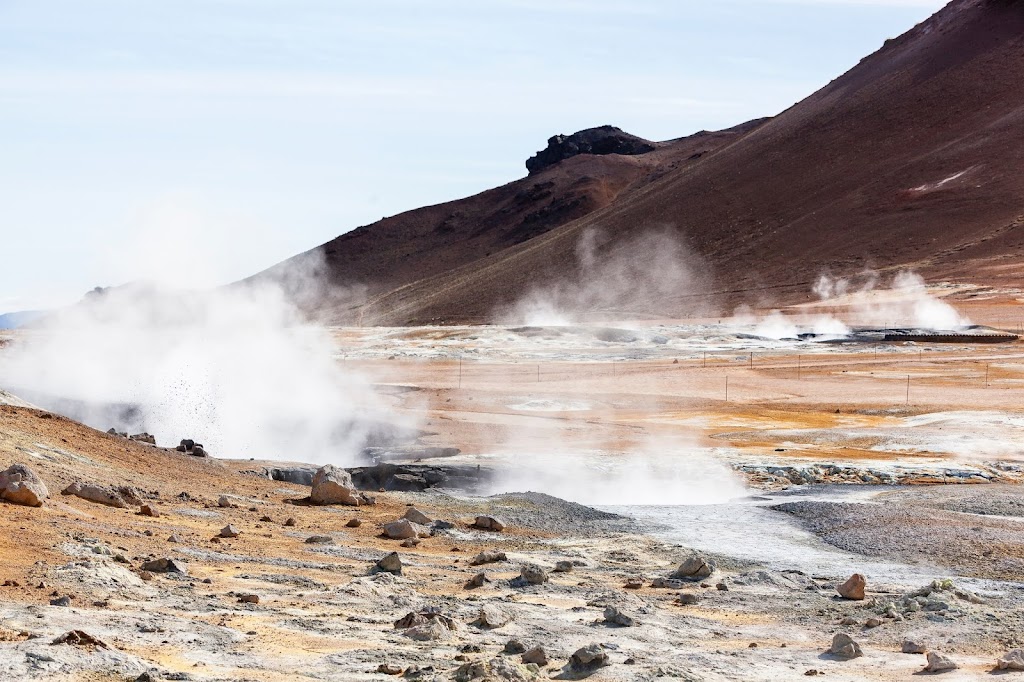Geothermal energy is a natural source of renewable energy which can be produced in specific geographical areas. The term geothermal originated from Greek words “Geo”, which means earth, and “therme” means heat. This energy can be generated where the water from the earth’s mantle comes out as steam due to the heat produced by the inner and outer core. The layers of earth are crust, mantle, outer core and the last is the inner core. Earth’s core produces energy in the form of heat into the atmosphere. This energy is called geothermal energy.
Photo by Matt Palmer on Unsplash
Geothermal energy- Natural renewable source:
Geothermal heat originates from earth’s blazing affiliation of gas and dust created over 4 billion years ago, called primordial heat. Also, the earth’s internal heat source is mainly imparted by the radioactive decay of long-lived unstable isotopes, namely 238U, 235U, 232Th and 40K and latent heat.
Temperatures may reach over 9,000 degrees Fahrenheit in the earth’s core which is about 4000 miles deep. Energy in the form of heat from the earth’s core endlessly flows outward, heating a surrounding layer of rock called the mantle. While the heat energy flows outward from the core, convection occurs in the mantle. Convection is defined as the cycle of motion that occurs when warmer air or liquid with faster moving molecules, making it less dense and so rises, simultaneously the cooler air or liquid drops down. By this concept, the hotter mantle rises to the earth’s surface; after it cools, it drops back lower and hence is heated again by the earth’s inner and outer core.
The high temperature and pressure in the mantle cause the rock to melt to form Magma. The release of Magma into the surface is called Lava. However, often the magma (melted rock) remains below the earth’s crust. Convection in the mantle heats the rock and water nearby, above 700 degrees Fahrenheit. Apart from this, heat comes from the radioactive decay of long-lived radioactive isotopes found in the mantle formed billions of years ago.
How electricity is generated from geothermal energy?
For electrical power production, geothermal resources are underground reservoirs of steam that can be tapped. High-temperature geothermal power can be generated in the presence of volcanic activity. Workers drill wells in the geothermal reservoirs to bring the hot water or steam to the surface through production wells.
People responsible for exploring, locating and testing the underground reservoirs are Geologists, geochemists, drillers and engineers. Once the hot water or steam travels
up the wells to the surface, they generate electricity by providing the force to run the turbine generators in geothermal power plants. The used geothermal water is reused by returning down an injection well into the reservoir to be reheated.
Three kinds of geothermal power plants:
- dry steam
- flash steam
- binary cycle.
Dry steam:
It is the first type of geothermal power plant built. A dry steam reservoir produces steam and very little water. The steam is funnelled directly into the power plant to provide the force to spin the turbine generator. The largest dry steam power plant in the world is The Geysers, located about 90 miles north of San Francisco, USA. It was started in 1960, which has become one of the most successful alternative energy projects in history.
Flash steam:
It produces mostly hot water and is used in a flash power plant. Through production wells, the water with a temperature of about 300 to 700 degree Fahrenheit and then released from the pressure and consequently, water flashes into steam in a separator. The steam is used to run a generator, which produces electricity.
Binary cycle:
The principle here is heat exchanging. Geothermal water with temperatures between 250–360 degrees Fahrenheit is insufficient to work as a flash steam. So, this can be solved by using a binary power plant. In this, the geothermal water is passed through a heat exchanger, where the heat is transferred into a second liquid, for example, isopentane, which boils at a lower temperature than water. When heated, the binary liquid flashes to vapour, expands across and spins the turbine. The vapour is then recondensed to a liquid and is reused repeatedly by using injection wells.
Disadvantages:
Natural substances, such as arsenic, boron, and mercury present in the water released from geothermal cooling towers. In addition to this, CO2, a greenhouse gas, is released from geothermal cooling towers. However, this release of carbon dioxide is less than one-tenth compared to a fossil fuel electrical generation facility of similar capacity.
Geothermal energy for the future:
A method called Enhanced Geothermal Systems, or simply EGS can be used for generating power. This system is an artificial reservoir created where there is hot rock but has insufficient permeability or fluid saturation. A fluid is injected into the earth’s subsurface by drilling, creating permeability and allowing fluid to circulate throughout the rock manually and thus transporting heat to the surface.
World’s first production of geothermal electricity in Larderello, Italy, in 1904. The USA is the leading producer in geothermal energy. Geothermal energy is currently generated in 26 countries, while geothermal heating is in use in about 70 countries all around the world.
Summary:
This renewable energy source can be generated from the steam which in turn runs the turbine to produce electricity.
Discover more from Aristoscienceworld
Subscribe to get the latest posts sent to your email.





